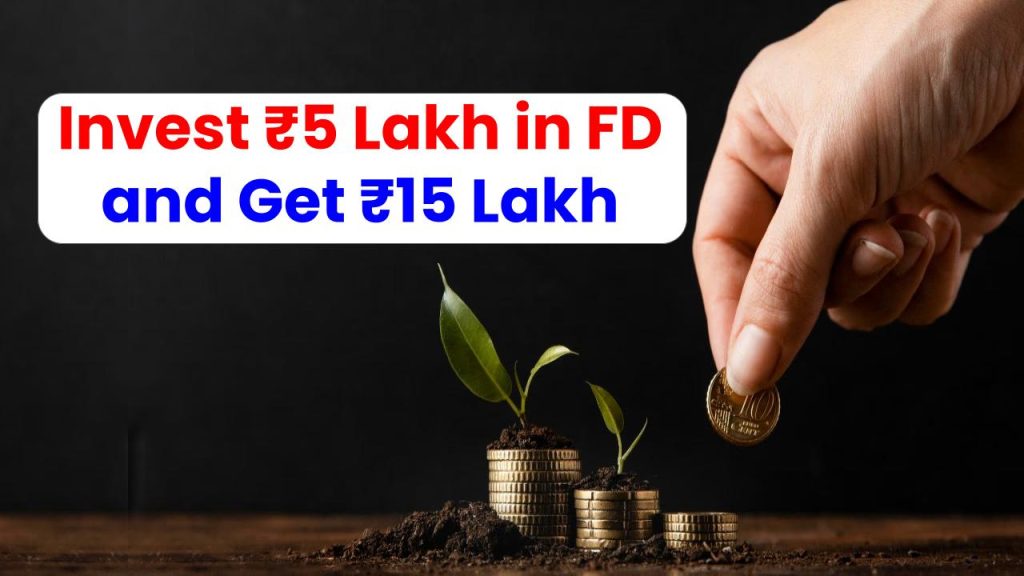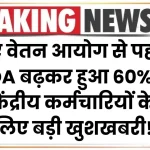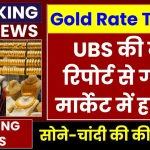
Are you wondering how to turn ₹5 lakh into ₹15 lakh through Fixed Deposit (FD) investments? It’s a question that interests both cautious savers and smart investors. Fixed Deposits have long been a trusted investment avenue in India, offering guaranteed returns with low risk. But can you really triple your money with an FD? The answer is yes—with the right strategy, interest rate, and time.
In this article, we’ll walk you through how to invest ₹5 lakh in an FD and grow it to ₹15 lakh, using real-life numbers, expert-backed guidance, and a simple step-by-step plan. Whether you’re a student, working professional, or retiree, this guide will help you make smarter, more rewarding choices.
Invest ₹5 Lakh in FD and Get ₹15 Lakh
| Feature | Details |
|---|---|
| Investment Amount | ₹5,00,000 |
| Target Amount | ₹15,00,000 |
| Required Interest Rate | 7% annually (compounded) |
| Approximate Time Needed | ~16.2 years |
| Best FD Rates (April 2025) | Up to 7.90% (IDFC FIRST Bank) |
| Risk Level | Low |
| Taxation | Interest is taxable under ‘Income from Other Sources’ |
| Recommended For | Risk-averse investors, retirees, conservative savers |
Investing ₹5 lakh in a Fixed Deposit and growing it to ₹15 lakh is very much possible—if you’re patient and strategic. With today’s FD rates nearing 7.5%-7.9%, you’re looking at a safe, long-term plan to triple your money in around 16 years. For risk-averse investors or those near retirement, this could be the perfect wealth-building tool.
You can maximize your FD investment using smart tactics like laddering, reinvesting matured funds, and staying updated with top interest rates. Combine this with tax planning, and you’re on a rock-solid path toward financial growth.
What is a Fixed Deposit (FD)?
A Fixed Deposit (FD) is a financial product offered by banks and post offices where you deposit a lump sum of money for a fixed period and earn interest on it. Once the term ends (called “maturity”), you receive your original amount plus the accumulated interest.
Unlike stocks or mutual funds, FDs are not linked to the market, which makes them ideal for low-risk investing.
Why are FDs so popular in India?
- Safe and regulated by RBI
- Guaranteed returns
- Flexible tenure (from 7 days to 10 years)
- Monthly, quarterly, or cumulative interest payout options
see also: Amrit Kalash FD Has Been Closed, Get More Interest in This Scheme
How to Grow ₹5 Lakh to ₹15 Lakh Using FD
Let’s use a simple formula from compound interest math: A=P×(1+r)nA = P \times (1 + r)^n
Where:
A= Final amount (₹15,00,000)P= Principal (₹5,00,000)r= Interest rate per year (e.g., 0.07 for 7%)n= Number of years
Example Calculation:
If you invest ₹5 lakh at 7% interest, compounded yearly: n=log(15,00,000/5,00,000)log(1+0.07)≈16.2 yearsn = \frac{\log(15,00,000 / 5,00,000)}{\log(1 + 0.07)} ≈ 16.2 \text{ years}
So, with a 7% FD, it would take you just over 16 years to triple your money.
Top FD Interest Rates in India (April 2025)
Here’s a quick list of some of the highest FD interest rates offered by top Indian banks as of April 2025:
| Bank | Max FD Rate (General Public) | Tenure |
|---|---|---|
| IDFC FIRST Bank | 7.90% | 400 Days |
| IndusInd Bank | 7.75% | 2 Years |
| Yes Bank | 7.75% | 3 Years |
| HDFC Bank | 7.25% | 15-24 Months |
| ICICI Bank | 7.25% | 15-18 Months |
| Post Office TD | 7.5% | 5 Years (compounded quarterly) |
Step-by-Step Guide: How to Invest ₹5 Lakh in an FD
Step 1: Choose the Right Bank or Scheme
Look for banks or post office schemes offering the highest interest rates for a long tenure. Senior citizens may get 0.25%-0.75% extra.
Step 2: Decide Between Cumulative or Non-Cumulative FD
- Cumulative FD: Interest is reinvested and paid at maturity (ideal for wealth building)
- Non-Cumulative FD: Interest paid monthly/quarterly (great for regular income)
Step 3: Use an FD Calculator
Use tools like the SBI FD Calculator or HDFC FD Estimator to estimate your returns.
Step 4: Submit Your KYC Documents
You’ll need:
- PAN Card
- Aadhaar Card
- Address Proof
- Passport-size photo
Step 5: Monitor and Reinvest Smartly
Once your FD matures, reinvest if you haven’t yet reached your target. This helps compound your gains faster.
Expert Tip: Consider Laddering Your FDs
FD Laddering means splitting your ₹5 lakh into smaller chunks across different tenures. For example:
- ₹1.5 lakh in 1-year FD
- ₹1.5 lakh in 3-year FD
- ₹2 lakh in 5-year FD
This helps:
- Avoid interest rate risk
- Ensure liquidity
- Maximize returns during rate hikes
Alternatives to Fixed Deposit for Faster Growth
If 16+ years feels too long, here are some safe alternatives with slightly higher returns:
PPF (Public Provident Fund)
- Interest: 7.1% (April-June 2025)
- Tax-free returns
- Lock-in: 15 years
- Ideal for long-term saving
SIP in Debt Mutual Funds
- Potential returns: 7%-9%
- Low risk
- Flexible withdrawal
Senior Citizen Savings Scheme (SCSS)
- Interest: 8.2% (current)
- Lock-in: 5 years
- Taxable interest
see also: How to Get Rs 49,943 Interest by Depositing Rs 2 Lakh in PNB FD Scheme
FD Investment FAQs
Q1. Can I break my FD early?
Yes, but banks may charge a penalty of 0.5% to 1% on the interest. Always check the terms.
Q2. Is interest from FD taxable?
Yes, FD interest is taxable under “Income from Other Sources”. If it exceeds ₹40,000 (₹50,000 for seniors), TDS at 10% is deducted.
Q3. Is FD a safe investment?
Absolutely. FDs in scheduled banks are covered by DICGC insurance up to ₹5 lakh per account holder, per bank.
Q4. Can I get monthly income from FD?
Yes. Choose a non-cumulative FD that pays interest monthly. Great for pensioners or those needing regular income.
Q5. What if FD interest rates fall after I invest?
No worries! Your interest rate is locked in for the tenure. That’s why long-term FDs are useful when rates are high.











